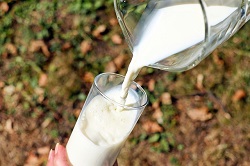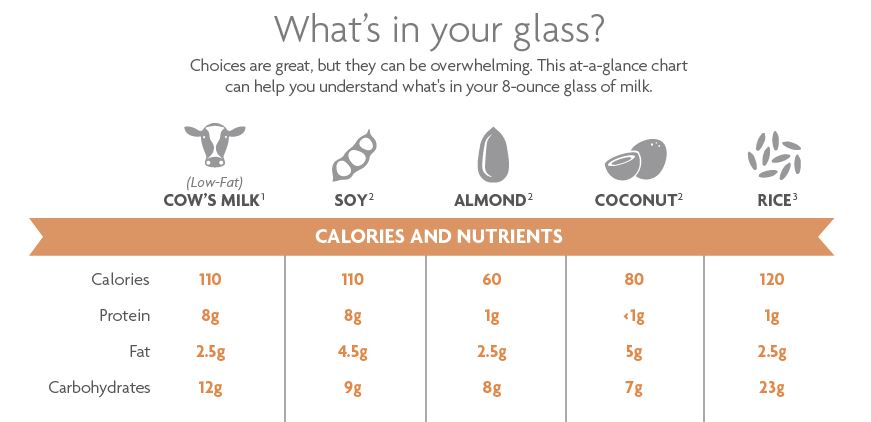 When I grew up, the term “milk” meant it was from a cow (our cows) and my only decision was whether to drink “whole” milk direct from the Holstein herd or buy “our processor” skim milk from the grocery store (which did not sit well with my father). Luckily, none of our family had a lactose intolerance or food allergy, so an “alternative milk” was never sought (nor could you have found it back then!). Milk seemed like one of nature’s “perfect foods,” and as I gained more formal nutritional knowledge along the way, I couldn’t disagree.
When I grew up, the term “milk” meant it was from a cow (our cows) and my only decision was whether to drink “whole” milk direct from the Holstein herd or buy “our processor” skim milk from the grocery store (which did not sit well with my father). Luckily, none of our family had a lactose intolerance or food allergy, so an “alternative milk” was never sought (nor could you have found it back then!). Milk seemed like one of nature’s “perfect foods,” and as I gained more formal nutritional knowledge along the way, I couldn’t disagree.
But times have changed and what seemed so simple and natural about milk has grown into a controversial and hotly contested debate over “what is milk?” Today, I can go to the local supermarket and find everything from dairy-based milks based on production methods, to lactose free milk, to a plethora of “milks” sourced from soy, nuts, rice, oats, peanuts, bananas and yes, even hemp. With the rapid expansion of plant-based “meat and milk,” the question of what constitutes the identity of these high-profile foods comes into play. The issue of whether we, as consumers, all have the same understanding is one that keeps regulatory agencies, consumer advocacy groups and respective commodity groups “up at night” and on different sides of the discussion at times. Regardless of the type of food or beverage we buy, there is a “standard of identity” and this is where the issue arises in the case of “milk.”
What is Standard of Identity?
When we see a label of identity on a food or beverage, we probably are not thinking about its “identity,” but we do expect a standard of product quality to exist. Standards of identity for food are mandatory requirements set by the Food & Drug Administration (FDA) that govern what a product must contain to be marketed under a certain name in allowable commerce. These standards are also designed to protect the consumer by ensuring the label accurately reflects the product contents.
In the current Code of Federal Regulations (Title 21, Vol 2, Part 131-Milk and Cream), milk is defined as “the lacteal secretion, practically free from colostrum, obtained by the complete milking of one or more healthy cows. Milk that is in final package form for beverage use shall have been pasteurized or ultrapasteurized, and shall contain not less than 8 1/4 percent milk solids not fat and not less than 3 1/4 percent milkfat.” 1
So perhaps you see the conflict? Even though there is a regulation, the FDA has not enforced it. The dairy industry (as well as others) would like to prevent nondairy beverages from being marketed as “milk,” in part because they see that term is misleading to the American consumer.
 In early 2018, the FDA stated it was their goal to “modernize certain standards of identity. In late Fall 2018, a request for comments on the “Use of the Names of Dairy Foods in the Labeling of Plant-Based Products” was opened through the end of January 2019. The FDA wanted to know if consumers understood the “differences between the basic nature, characteristics, ingredients and nutritional content of plant-based products and their dairy counterparts.”
In early 2018, the FDA stated it was their goal to “modernize certain standards of identity. In late Fall 2018, a request for comments on the “Use of the Names of Dairy Foods in the Labeling of Plant-Based Products” was opened through the end of January 2019. The FDA wanted to know if consumers understood the “differences between the basic nature, characteristics, ingredients and nutritional content of plant-based products and their dairy counterparts.”
Numerous surveys were conducted and comments were submitted to inform future decisions. Perhaps not surprising, the IFIC Foundation’s Consumer Attitudes about Labeling Cow’s Milk, Plant Based and Non-Dairy Alternatives found that about 75 percent of consumers understood which products contained and did not contain dairy milk, and only one in 10 consumers stated that milk from cows may be contained in the various plant based milks.2 But do consumers know if a nutritional difference exists?
Is It About the Name or Nutrition?
In the Consumer Reports Plant-Based Survey, a nationally representative sample of the U.S. population, the results show there is variance of understanding regarding the nutrient value of plant-based milks versus cow’s milk. When consumers were asked whether plant-based milk has more, the same, or less nutrients than what is found in cow’s milk (protein, calcium, vitamin A and potassium), a total of 52 percent believed plant-based milk had more nutrients (27 percent) or the same (25 percent), and 20 percent did not know. Only 26 percent responded that plant-based milks had less nutrients. Even more surprising was the fact that of consumers who said they usually or always purchase plant-based milk, 42 percent thought plant-based milks have more nutrients than cow’s milk, compared to 22 percent who usually or always purchase cow’s milk. 3
So why is this information important? It can affect your health or the health of your children. Scientific literature has reported in recent years that children experience Vitamin D and protein deficiencies when plant-based milks were given without additional nutritional supplementation. Recent studies show that of the plant-based milks, soy-based milks have the closest nutritional value to cow’s milk. Regardless of what has been written about the “dairy bias” of the Dietary Guidelines for Americans, there is a reason for including three servings per day of dairy due to the nutritional profile.
The National Dairy Council has prepared a side-by-side comparison of cow’s milk, soy, almond, coconut and rice-based beverages. Check out a sneak peek below or download the full piece here.
The Informed Consumer
Even though cow’s milk will always be my first preference for a “milk beverage,” I recognize it is not for everyone. As a registered dietitian who has worked with food allergic clients, I have recommended alternatives, but at the same time, informed them of the nutrients that need to be replaced by other food sources. Whether we prefer cow’s milk or a plant-based option due to taste, diet, lifestyle, or environmental or antibiotic concerns, the bottom line is we need to recognize that differences do exist. Numerous comments filed with the FDA, including Consumer Reports, concluded that changes in labeling need to happen. If and when this may occur depends on FDA leadership and when leadership changes within the agency, priorities can change as well. Until then, the next time you pick up a container of “milk” read the label and know what you are buying. Be the informed consumer.
References
1. Code of Federal Regulations, Title 21, Vol 2, Part 131-Milk and Cream
2. IFIC Foundation’s Consumer Attitudes About Labeling Cow’s Milk, Plant Based And Non-Dairy Alternatives,
October 2018
3. CR Comments to FDA and Survey Report on the Names of Dairy Foods in the Labeling of Plant-Based Products, January 31, 2019

